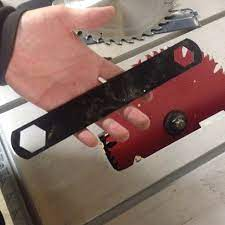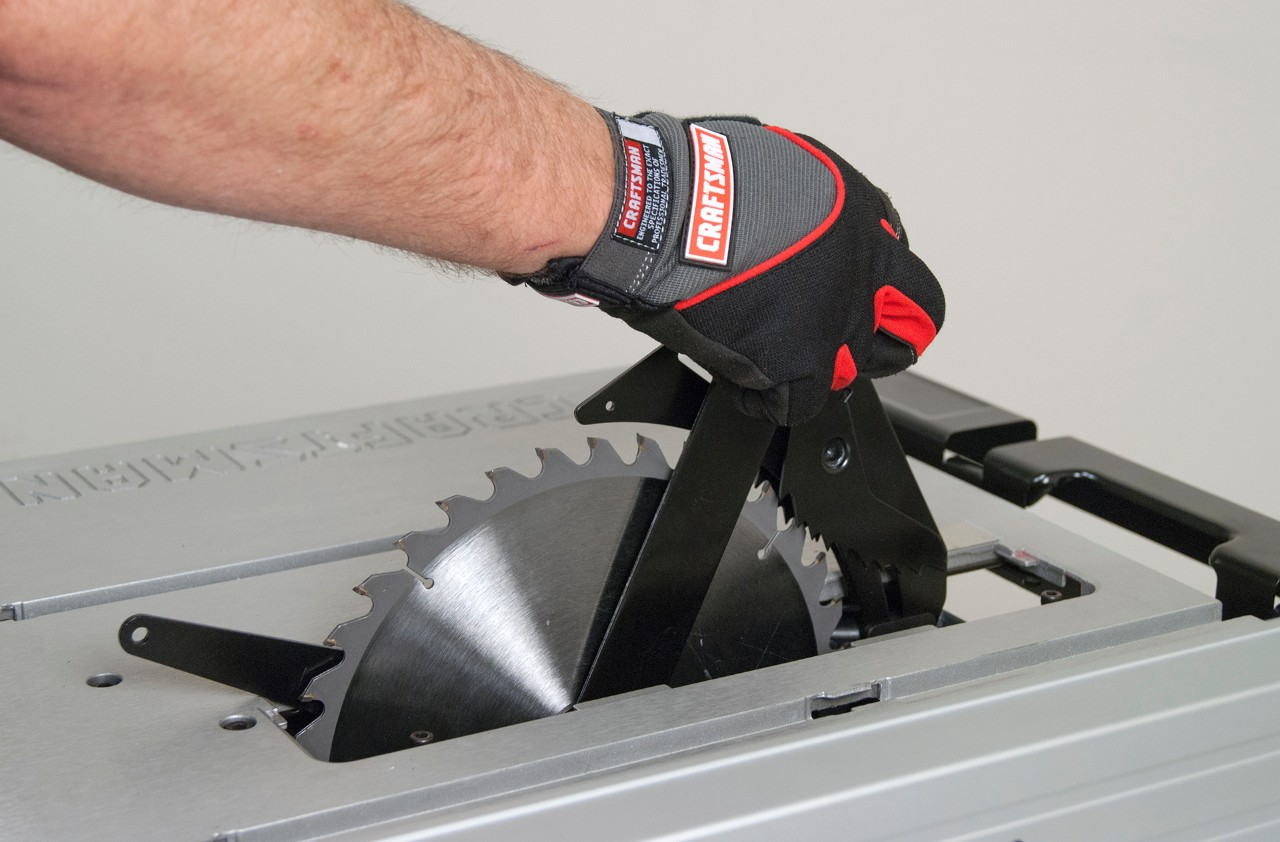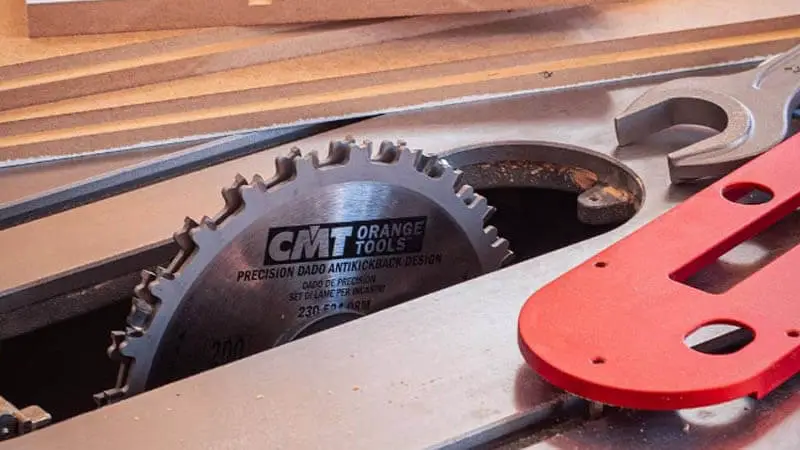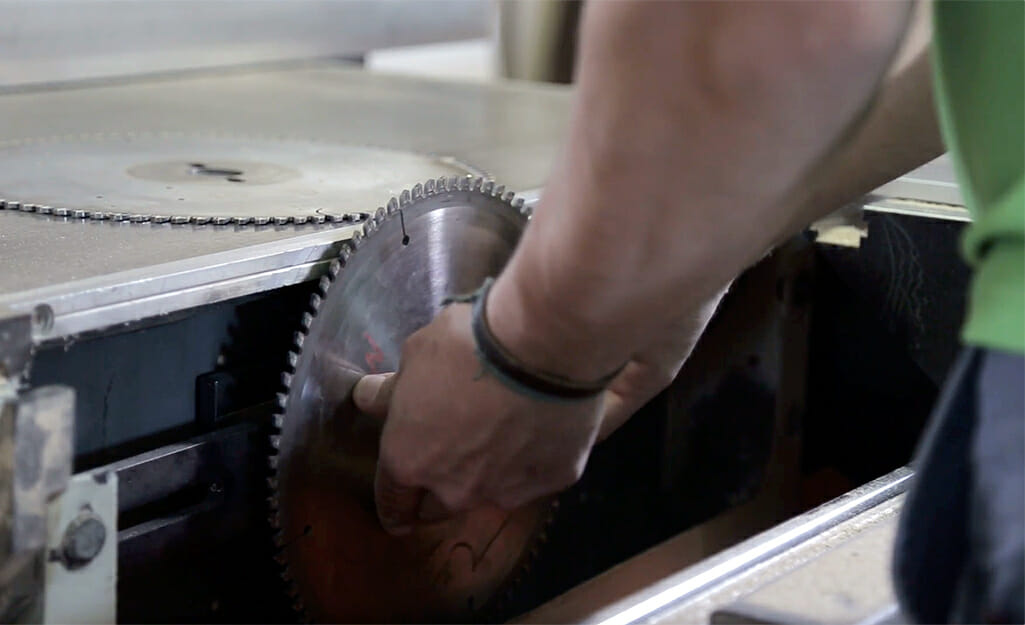Changing a table saw blade can be a daunting task, especially if you don’t have the right tools on hand. However, there are a few tricks you can try to change the blade without a wrench. Firstly, some blades have a small screw or locking pin that holds them in place.
How to Change Table Saw Blade Without Wrench? Step By Step Guideline
If for same reason you find yourself needing to change the blade on your table saw but don’t have a wrench available, don’t worry – it’s still possible to do so safely and effectively. Here’s a step-by-step guideline on how to change a table saw blade without a wrench.
Step 1: Unplug the saw – For safety reasons, you should always unplug the saw before you attempt to change the blade.
Step 2: Raise the blade to maximum height – Use two wrenches, one wrench or the saw’s height adjustment knob to raise the blade to its highest position. This will make it easier to access the blade and remove it.
Step 3: Remove the blade guard – Some saws have a blade guard that needs to be removed before you can access the blade. Check your saw’s user manual for instructions on how to remove the old blade guard.
Step 4: Remove the blade nut and washer and loosen the nut or bolt – Depending on the saw, the blade may be held in place by a nut or bolt. If you don’t have a wrench, try using pliers to simply loosen both the top nut and washer loosen the nut or bolt. Grip the nut or bolt firmly with the pliers and turn it counterclockwise to loosen it. Once it’s loose enough, you should be able to remove the blade by hand.
Step 5: Remove the front blade lock – With the nut or bolt loose, carefully using one wrench to lift the front blade lock off the arbor and set it aside.
Step 6: Install screws on the new blade – Place the new blade onto the arbor, tightening and making sure that the blade teeth are facing forward. Reinstall the nut or bolt and tighten it securely. Use your pliers or screwdriver to give it a final tighten if necessary.
Step 7: Reinstall the blade guard – If you removed the blade guard in Step 3, reinstall it now.
Step 8: Lower the blade – Use the height adjustment knob to lower or push the blade back to its original position.
Step 9: Test the blade plate of saw – Turn on the saw and check that the blade plate is spinning smoothly and without wobbling. Check that the blade plate and guard is in place and functioning properly.
By following these steps, you should be able to change your table saw blade without a wrench. Remember to always exercise caution and follow the manufacturer’s instructions when working with power tools.
When Should You Change The Blade?
It’s important to change the blade on your table saw when it starts to show signs of wear and tear or damage. Here are some signs that may indicate it’s time to change the circular saw blade:
- Dullness – If your blade is not cutting as cleanly and quickly as it used to, it may have become dull. Dull blades can cause rough cuts, burning or scorching of the wood, or even kickback, which can be dangerous.
- Chipped or broken teeth – If you notice that some of the teeth on the blade are chipped, broken or missing altogether, it’s time to replace the blade. A blade with damaged teeth will not cut cleanly and can cause uneven cuts or even damage the saw.
- Bent blade – If you accidentally hit a nail or another hard object while cutting, your blade may become bent or warped. A bent blade can cause rough cuts or binding, and may even be dangerous to use.
- Rust or corrosion – If your blade has rust or corrosion on it, it may affect the blade’s ability to cut cleanly and smoothly. Rust can also weaken the blade, making it more prone to breakage.
It’s important to note that a worn-out blade not only affects the quality of your cuts but can also be dangerous to use. Always inspect your blade before using your saw, and if you notice any signs of damage or wear, replace it promptly to ensure your safety and the quality of your work.
What is An Arbor Wrench?

An arbor wrench is a specialized tool that is used to change the blade on a table saw or other power tools with rotating blades. The arbor wrench is a long, thin, L-shaped tool that is specifically designed to fit into the blade arbor, which is the mechanism that holds the blade in place on the power tool’s motor shaft. The wrench has a square hole on one end that fits over the arbor’s nut or bolt, while the other end of only wrench has a curved shape that allows you to apply torque to the nut or bolt to either loosen the nut or tighten it.
Arbor wrenches come in different sizes to fit different arbor nuts or bolts, and they are usually included with the tool when you purchase it. They are an important tool for anyone who works with table saws or other power tools with rotating blades, as they allow you to safely and securely change the blades without risking injury to yourself or damage to the power tool itself. It’s important to always use the correct size arbor wrench when changing the blade to ensure a secure and safe fit of adjustable wrench to the blade.
Step 1. Turning the Power Off
changing a table saw blade is to turn the power off. Before you do anything else, it’s essential to make sure that the power switch on your saw is not connected to any power source. This means unplugging it from the wall, or if it’s a cordless saw, removing the battery.
Turning off the power is important for your safety. You don’t want to accidentally start the table saw while changing the blade, as this can result in serious injury. Always take the time to double-check that the power is off before proceeding to the next step. Once you have confirmed that the table saw itself is not connected to a power source, you can move on to the next step in the process of changing the table saw blade.
Step 2 Remove the Plate That Covers Blade
same method of changing a table saw blade is to remove the throat plate that covers the blade and then how to change table saw blade without wrench on top throat plate. Most table saws come with a throat plate or wooden block or guard that covers the blade to protect the user from accidental contact with the blade.
To remove the plate, locate the screws or bolts that hold it in place, and use the appropriate tool to loosen and remove them. Set metal plate and the screws or bolts aside in a safe place, so you don’t lose them. Once you’ve removed the plate, you’ll be able to see the blade and its arbor nut or bolt.
It’s essential to remove the plate before attempting to change the blade to ensure that you have easy access to the blade and its arbor. Never attempt to change the blade without first removing the plate, as this can result in serious injury.
Which way does a table saw blade go?
A table saw blade typically has teeth that are angled to cut in a specific direction. The blade is designed to cut in a clockwise direction when viewed from above, which means that the bottom of the table see blade moves forward while the top moves backward.
Elimination of Blade
Step 3 of changing a table saw blade is to eliminate the blade from the saw. To do this, locate the arbor nut or bolt that is holding the blade in place. The arbor nut or bolt is typically located in the center of the blade and is used to secure the blade onto the arbor shaft.
Using the correct-sized arbor wrench, turn the nut or bolt counterclockwise to loosen it. Once it is loose enough, you can remove the nut or bolt with your fingers and set it aside in a safe place.
Next, gently lift the old blade off of the arbor lock shaft, taking care not to touch the teeth of the arbor lock with the blade. You may need to wiggle the blade a bit to loosen it from the arbor lock itself. Once the blade is removed, set it aside in a safe place.
It’s important to handle the blade with care to avoid any injury or damage to the blade. Always wear gloves when handling the blade, and be sure to keep your hands away from the sharp teeth.
Step 3. Removing the Blade
Step 3 of changing a table saw blade is to remove the old blade from the arbor shaft. To do this, locate the arbor nut or bolt that secures the blade onto the arbor shaft.
Using the correct-sized arbor wrench, turn the nut or bolt counterclockwise to loosen it. Once it is loose enough, you can remove the nut or bolt with your fingers and set it aside in a safe place.
Next, gently lift the old blade off of the arbor shaft, taking care not to touch the teeth of the blade. You may need to wiggle the blade a bit to loosen it from the arbor. Once the blade is removed, set it aside in a safe place.
Step 4. Attaching the New Blade

Step 4 of changing a table saw blade is to attach the new blade to the arbor shaft. Before you do this, make sure that the new blade is suitable for your table saw and that its teeth are facing in the correct direction.
To attach the new blade, place it onto the arbor shaft, making sure that it fits snugly against the arbor flange. Then, replace the arbor nut or bolt onto the shaft, making sure to turn it clockwise to tighten it.
Using the arbor wrench, tighten the nut or bolt firmly, but be careful not to overtighten it, as this can cause damage to the blade or the arbor.
Once you’ve attached the new blade, double-check to make sure that it is securely fastened to the arbor shaft. Give the blade a gentle tug to make sure it is not loose.
It’s essential to ensure that the new blade is correctly attached before proceeding to the next step. A loose blade can cause serious injury, so always take the time to double-check that the blade is securely fastened.
Are Table Saw Blades Reverse Threaded?

No, most table saws’ blades are not reverse threaded. They have a regular right-hand thread, blades reverse threaded which means they tighten in a clockwise direction and loosen in a counterclockwise direction. However, there are some specialty table saw blades made that may have a reverse thread, so it’s always a good idea to consult the manufacturer’s instructions or consult a professional if you are unsure. Additionally, it’s important to make sure that the blade is properly secured and tightened before using the table saw to prevent any accidents or injuries.
Precautions While Changing Table Saw Blade Without Arbor Wrench

Changing a table saw blade without an arbor wrench can be challenging and potentially dangerous if proper precautions are not taken. Here are some precautions you should consider when changing a table saw blade without an arbor wrench:
- Turn off the power: Before beginning any work on the saw, ensure that the power is turned off and the blade has stopped moving. Unplug the saw from the power source to prevent any accidental starts.
- Use protective gear: Wear protective gear such as safety glasses and gloves to protect your eyes and hands.
- Find a suitable replacement tool: Look for a suitable replacement tool such as pliers, a screwdriver or an adjustable wrench that can be used to loosen and tighten the blade.
- Secure the blade: Use a piece of wood to hold the blade in place while you remove the blade nut. Be sure to secure the blade properly to avoid any accidental movement.
- Follow the manufacturer’s instructions: Always follow the manufacturer’s instructions for removing and installing the blade. If you’re unsure of what to do, seek the help of a professional.
- Double-check the blade nut: After installing the new blade, make sure to tighten the blade nut properly before using the saw again. Check the blade for wobbling or any other irregularities before powering the saw back on.
FAQS
- What is a table saw used for? A table saw is a power tool used for cutting wood and other materials. It consists of a circular saw blade mounted on an arbor that is driven by an electric motor.
- What safety precautions should I take when using a table saw? When using a table saw, you should wear protective gear such as safety glasses, ear protection, and gloves. Make sure that the blade guard is in place and the saw is properly adjusted. Always keep your hands and fingers away from the blade, and use push sticks or other tools to feed the material into the saw.
- How do I change the blade on my table saw? To change the blade on a table saw, first unplug the saw and remove the blade guard. Loosen the arbor nut using an arbor wrench, remove the old blade, and install the new blade, making sure to align it properly. Tighten the arbor nut securely and reattach the blade guard.
- How do I adjust the blade height on my table saw? To adjust the blade height on a table saw, locate the height adjustment knob or crank and turn it to raise or lower the blade. Make sure that the blade is adjusted to the appropriate height for the material you’re cutting.
- What types of blades can I use on my table saw? There are many different types of blades available for table saws, including rip blades, crosscut blades, combination blades, and dado blades. The type of blade you should use depends on the material you’re cutting and the type of cut you want to make.
- How do I maintain my table saw? To maintain your table saw, you should keep it clean and free of debris, lubricate the moving parts regularly, and check the blade alignment and tension regularly. You should also replace worn or damaged parts as needed and follow the manufacturer’s instructions for maintenance and care.
Conclusion
A table saw is a powerful tool that is commonly used for woodworking and other applications. It’s important to follow safety precautions when using a table saw, including wearing protective gear, keeping your hands and fingers away from the blade, and using push sticks or other tools to feed the material into the saw.
When changing the blade or adjusting the arbor nut, it’s important to use caution and follow the manufacturer’s instructions. Always ensure that the blade is properly aligned and securely tightened before using the saw. Additionally, maintaining your table saw through regular cleaning, lubrication, and part replacement is essential for optimal performance and safety.
